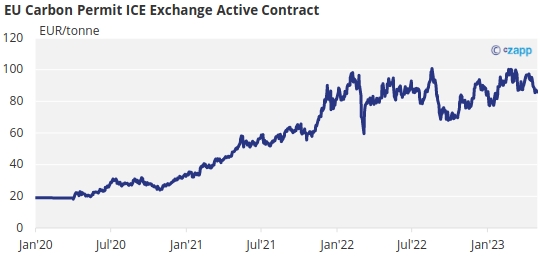Insight Focus
- Fewer European carbon allowances in the market in 2023.
- Changes to the market’s auctioning regulations will take longer to complete.
- Prices are back to around €90.
EU carbon prices climbed sharply on Tuesday after the European Commission said it would be putting fewer extra allowances into the market than expected in 2023, as changes to the market’s auctioning regulations will take longer to complete.

Early this year the EU approved measures to support speeding up the bloc’s transition away from fossil fuels after Russia’s invasion of Ukraine triggered massive increases in the price of natural gas,
The REPowerEU initiative was designed to channel extra funding to help member state transition to renewable and other low-carbon energy sources, with a pot of more than €200 billion created to help pay for the shift.
Some €20 billion of this total was earmarked to be generated by selling additional EU emission allowances (EUAs) into the market between 2023 and 2026. Some of the allowances would be brought forward from member state auction reserves set aside for the period between 2027 and 2030, and others diverted from an Innovation Fund to support new technologies.
A commission official confirmed on Tuesday that only some 16.5 million extra EUAs will be sold starting in June, as changes to the regulation governing the sale of Innovation Fund EUAs will not be completed before the end of the year.
Analysts had estimated that the Innovation Fund portion of the sales could have amounted to between 20 and 40 million EUAs in 2023, and the delay to this supply triggered a sharp move upwards in EUA prices on Tuesday morning.
Levels rose from as low as €85.42 to €90.85 within the space of the morning session, as traders absorbed the loss of anticipated supply.
The EU ETS last week also completed its annual compliance cycle, in which covered installations were required to surrender EUAs matching their verified emissions to the Commission.
The compliance process typically leads to an increase in EUA prices as industrial and energy companies top up their accounts ahead of the April 30 deadline, but this year the month of April saw a 5% decrease in prices after factories reported a surprise 1.2% decline in emissions in 2022.
The drop in CO2 reflected a sharp reduction in industrial output due to soaring energy costs, which was only partially offset by an increase in power sector emissions as utilities switched away from burning expensive natural gas and used more coal, which emits roughly twice as much CO2 per unit of power generated.
The outlook for European carbon prices is now seen as slightly bearish, as the end of compliance robs the market of prompt demand, while the anticipation of at least some additional volumes from the REPowerEU initiative starting in June suggests supply will be more than comfortable in the coming months.
The Commission amendments to the auctioning regulations are also expected to change the profile of auction supply in the month of August, as the compliance cycle is set to move from March-April to August-September starting in 2024.
At present, auction supply is reduced by half in August, when demand is at its lowest due to the summer holiday season. But from 2024, the compliance deadline will shift from April 30 to September 30, meaning that the month of August will become a key period for industrials to buy any remaining EUAs they will need to achieve compliance.
The reporting deadline of March 31 will not change; instead companies will have an additional five months in which to accumulate the EUAs they need to surrender to the Commission. The delay will also give member state governments more time to compute any changes to the allocation of free EUAs to factories based on changes in output.














